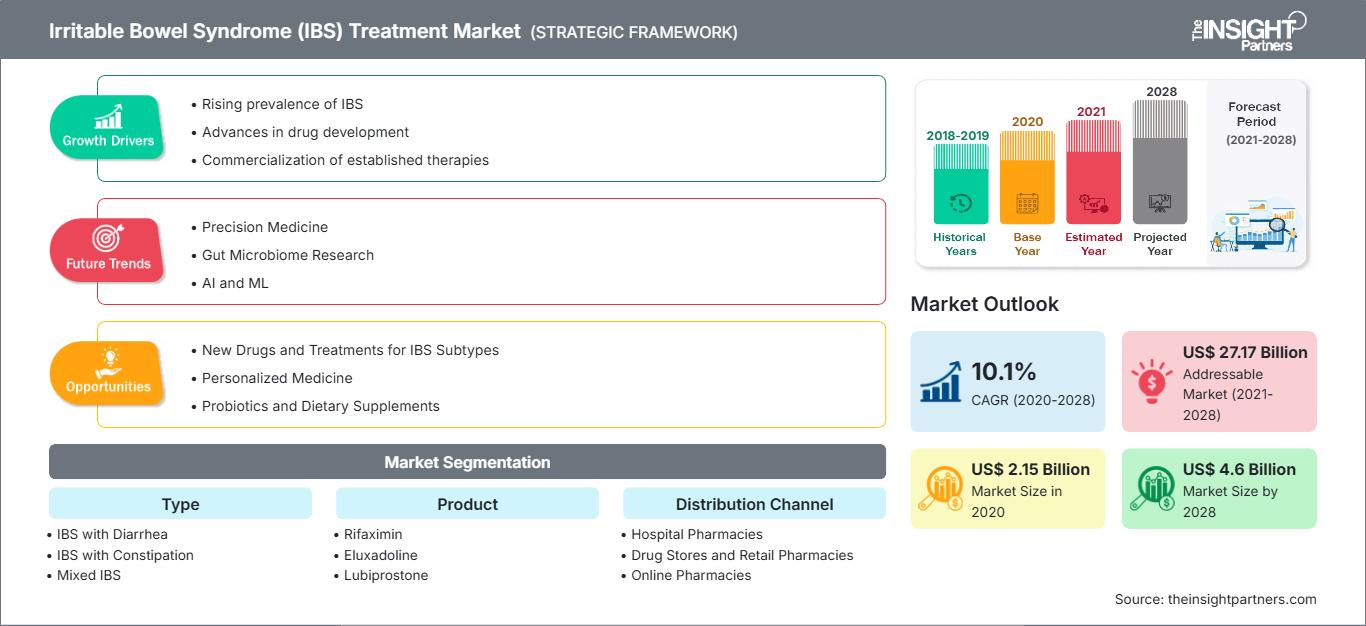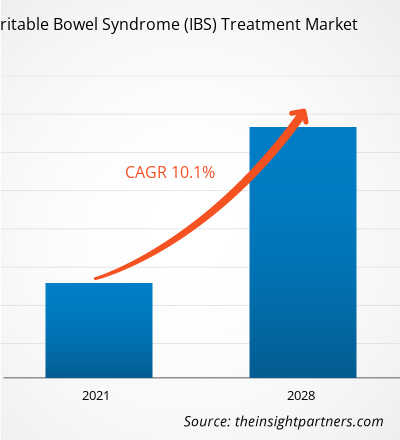Der Markt für die Behandlung des Reizdarmsyndroms (IBS) wurde im Jahr 2020 auf 2.153,89 Millionen US-Dollar geschätzt und soll bis 2028 4.600,30 Millionen US-Dollar erreichen; von 2021 bis 2028 wird ein CAGR-Wachstum von 10,1 % erwartet.
Die Hauptfaktoren wie die zunehmende Prävalenz von Reizdarmsyndrom-Erkrankungen und steigende Forschungs- und Entwicklungsaktivitäten treiben das Marktwachstum voran. Die begrenzte Produktverfügbarkeit und ineffiziente Behandlungen bremsen jedoch das Marktwachstum. IBS ist eine häufige chronische Erkrankung, die das Bauchorgan, den Dickdarm, betrifft. Sie wird auch als spastischer Dickdarm, muköse Colitis, Reizdarm oder spastische Colitis bezeichnet. Die Erkrankung unterscheidet sich stark von einer entzündlichen Darmerkrankung. Sie zeigt Symptome wie Krämpfe, Bauchschmerzen, Blähungen, Durchfall oder Verstopfung oder beides gleichzeitig. Leichte Symptome können durch Stressreduzierung, Lebensstil- und Ernährungsumstellung gelindert werden. Schwere Symptome werden hingegen mit Medikamenten und Beratung behandelt.
In der Asien-Pazifik-Region wurden zahlreiche Maßnahmen ergriffen, um die Ausbreitung des neuartigen Coronavirus, das COVID-19 verursacht, einzudämmen. Diese Maßnahmen haben den Betrieb vieler Unternehmen in verschiedenen Branchen, darunter auch im Gesundheitswesen, beeinträchtigt. Personalquarantäne, Ausfälle in der Lieferkette und Nachfragerückgänge haben zu ernsthaften Komplikationen für die Unternehmen geführt. Auch die stationäre und ambulante Versorgung privater Krankenhausketten ist deutlich zurückgegangen. Um die Gesundheitssysteme zu entlasten, verschieben viele Kliniken nicht kritische Termine. Dieses Szenario behindert die weitere Entwicklung der Behandlung des Reizdarmsyndroms (RDS).
Passen Sie diesen Bericht Ihren Anforderungen an
Sie erhalten kostenlos Anpassungen an jedem Bericht, einschließlich Teilen dieses Berichts oder einer Analyse auf Länderebene, eines Excel-Datenpakets sowie tolle Angebote und Rabatte für Start-ups und Universitäten.
Markt für die Behandlung des Reizdarmsyndroms (IBS): Strategische Einblicke

-
Holen Sie sich die wichtigsten Markttrends aus diesem Bericht.Dieses KOSTENLOSE Beispiel umfasst Datenanalysen, die von Markttrends bis hin zu Schätzungen und Prognosen reichen.
Markteinblicke
Zunehmende Prävalenz des Reizdarmsyndroms und damit verbundener Erkrankungen
Das Reizdarmsyndrom ist eine häufig beobachtete chronische Magen-Darm-Erkrankung, die durch Störungen der Stuhlgewohnheiten und Bauchschmerzen verursacht wird. Die Krankheit ist auch als spastisches Kolon, Reizdarmsyndrom, muköse Colitis oder spastische Colitis bekannt. Das Reizdarmsyndrom zeigt Symptome wie Bauchschmerzen, Verstopfung, Durchfall und Krämpfe. Die Gesundheitssysteme in allen Regionen verzeichnen einen erheblichen Anstieg der Fälle des Reizdarmsyndroms. Von der International Foundation for Gastrointestinal Disorders veröffentlichte Daten besagen, dass etwa 40 % aller IBS-Patienten ein leichtes IBS haben, etwa 35 % ein mittelschweres IBS und schätzungsweise 25 % ein schweres IBS. Viele Menschen erkennen die Symptome des IBS nicht.
Zu den Risikofaktoren, die ein Reizdarmsyndrom verursachen können, gehören bestimmte Faktoren wie Nahrungsmittelallergien, sich entwickelnde Stadien einer Gastroenteritis, sporadische Bewegungen des Dickdarms, eine abnorme Serotoninzusammensetzung im Dickdarm und leichte Zöliakie. Diese Faktoren werden voraussichtlich die Verbreitung des Reizdarmsyndroms weltweit beschleunigen. Einer 2018 im NCBI veröffentlichten Studie zufolge sind beispielsweise jährlich schätzungsweise 10 bis 16 % der US-Bevölkerung vom Reizdarmsyndrom betroffen. Diese erschreckend hohe Verbreitung des Reizdarmsyndroms wird den Markt für die Behandlung des Reizdarmsyndroms (RDS) im Prognosezeitraum voraussichtlich ankurbeln.
Typbasierte Erkenntnisse
Basierend auf dem Typ ist der Markt für die Behandlung des Reizdarmsyndroms (RDS) in gemischtes RDS (RDS-M), RDS mit Durchfall (RDS-D) und RDS mit Verstopfung (RDS-C) segmentiert. Im Jahr 2020 hatte das Segment des gemischten Reizdarmsyndroms (IBS-M) den größten Marktanteil. Außerdem wird für dasselbe Segment im Prognosezeitraum die höchste durchschnittliche jährliche Wachstumsrate (CAGR) erwartet. Die steigende Prävalenz des Reizdarmsyndroms bei Frauen und Männern dürfte die Nachfrage nach Medikamenten zur Behandlung kombinierter Symptome von Verstopfung und Durchfall ankurbeln. Die Prävalenz des Reizdarmsyndroms ist in der alternden Bevölkerung höher. Daher wird die Nachfrage nach Medikamenten zur Behandlung des gemischten Reizdarmsyndroms im Prognosezeitraum voraussichtlich deutlich steigen.
Produktbasierte Erkenntnisse
Basierend auf dem Produkt ist der Markt für die Behandlung des Reizdarmsyndroms (IBS) in Rifaximin, Eluxadolin, Lubiproston, Linaclotid und andere segmentiert. Das Segment Linaclotid hatte im Jahr 2020 den größten Marktanteil. Außerdem wird für dasselbe Segment im Prognosezeitraum die höchste durchschnittliche jährliche Wachstumsrate (CAGR) auf dem Markt erwartet. Das Marktwachstum in diesem Segment ist auf Faktoren wie die zunehmende Produktion von Generika von Linaclotid und die zunehmende Marktkonsolidierung bei der Entwicklung und Vermarktung von Linaclotid zur Behandlung des Reizdarmsyndroms zurückzuführen.
Einblicke auf Basis von Vertriebskanälen
Basierend auf den Vertriebskanälen ist der Markt für die Behandlung des Reizdarmsyndroms (RDS) in Krankenhausapotheken, Drogerien und Einzelhandelsapotheken sowie Online-Apotheken unterteilt. Im Jahr 2020 hielten die Krankenhausapotheken den größten Marktanteil. Es wird jedoch erwartet, dass das Segment Drogerien und Einzelhandelsapotheken im Prognosezeitraum die höchste durchschnittliche jährliche Wachstumsrate (CAGR) verzeichnen wird.
Unternehmen, die im Markt für die Behandlung des Reizdarmsyndroms (RDS) tätig sind, verfolgen eine Strategie der Produktinnovation, um den sich weltweit wandelnden Kundenanforderungen gerecht zu werden und so ihren Markennamen auf dem Weltmarkt zu behaupten.
Behandlung des Reizdarmsyndroms
Regionale Einblicke in den Markt für die Behandlung des Reizdarmsyndroms (IBS)Die Analysten von The Insight Partners haben die regionalen Trends und Faktoren, die den Markt für die Behandlung des Reizdarmsyndroms (RDS) im Prognosezeitraum beeinflussen, ausführlich erläutert. In diesem Abschnitt werden auch die Marktsegmente und die geografische Lage in Nordamerika, Europa, dem asiatisch-pazifischen Raum, dem Nahen Osten und Afrika sowie Süd- und Mittelamerika erörtert.
Umfang des Marktberichts zur Behandlung des Reizdarmsyndroms (IBS)
| Berichtsattribut | Einzelheiten |
|---|---|
| Marktgröße in 2020 | US$ 2.15 Billion |
| Marktgröße nach 2028 | US$ 4.6 Billion |
| Globale CAGR (2020 - 2028) | 10.1% |
| Historische Daten | 2018-2019 |
| Prognosezeitraum | 2021-2028 |
| Abgedeckte Segmente |
By Typ
|
| Abgedeckte Regionen und Länder |
Nordamerika
|
| Marktführer und wichtige Unternehmensprofile |
|
Dichte der Marktteilnehmer zur Behandlung des Reizdarmsyndroms (IBS): Verständnis ihrer Auswirkungen auf die Geschäftsdynamik
Der Markt für die Behandlung des Reizdarmsyndroms (RDS) wächst rasant. Die steigende Nachfrage der Endverbraucher ist auf Faktoren wie veränderte Verbraucherpräferenzen, technologische Fortschritte und ein stärkeres Bewusstsein für die Produktvorteile zurückzuführen. Mit der steigenden Nachfrage erweitern Unternehmen ihr Angebot, entwickeln Innovationen, um den Bedürfnissen der Verbraucher gerecht zu werden, und nutzen neue Trends, was das Marktwachstum weiter ankurbelt.

- Holen Sie sich die Markt für die Behandlung des Reizdarmsyndroms (IBS) Übersicht der wichtigsten Akteure
Markt für die Behandlung des Reizdarmsyndroms (IBS) – nach Typ
- IBS mit Durchfall (IBS-D)
- IBS mit Verstopfung (IBS-C)
- Gemischtes IBS (IBS-M)
Markt für die Behandlung des Reizdarmsyndroms (IBS) – nach Produkt
- Rifaximin
- Eluxadolin
- Linaclotid
- Lubiproston
- Sonstige
Markt für die Behandlung des Reizdarmsyndroms (IBS) – nach Vertriebskanal
- Krankenhäuser, Apotheken
- Drogerien und Apotheken
- Online-Apotheken
Markt für die Behandlung des Reizdarmsyndroms (IBS) – nach Geografie
-
Nordamerika
- USA
- Kanada
- Mexiko
-
Europa
- Frankreich
- Deutschland
- Italien
- Vereinigtes Königreich
- Spanien
- Rest von Europa
-
Asien-Pazifik (APAC)
- China
- Indien
- Südkorea
- Japan
- Australien
- Rest von APAC
-
Naher Osten und Afrika (MEA)
- Südafrika
- Saudi Arabien
- VAE
- Rest von MEA
-
Süd und Mittelamerika (SCAM)
- Brasilien
- Argentinien
- Rest von SCAM
Unternehmensprofile
- Ironwood Pharmaceuticals, Inc.
- AbbVie.
- Sebela Pharmaceuticals, Inc.
- Takeda Pharmaceutical Company Limited
- Alfasigma SpA
- Astellas Pharma Inc.
- AstraZeneca
- Synthetic Biologics, Inc.
- Bausch + Lomb Incorporated
- Lannett Company Inc
- Historische Analyse (2 Jahre), Basisjahr, Prognose (7 Jahre) mit CAGR
- PEST- und SWOT-Analyse
- Marktgröße Wert/Volumen – Global, Regional, Land
- Branchen- und Wettbewerbslandschaft
- Excel-Datensatz
Aktuelle Berichte
Erfahrungsberichte
Grund zum Kauf
- Fundierte Entscheidungsfindung
- Marktdynamik verstehen
- Wettbewerbsanalyse
- Kundeneinblicke
- Marktprognosen
- Risikominimierung
- Strategische Planung
- Investitionsbegründung
- Identifizierung neuer Märkte
- Verbesserung von Marketingstrategien
- Steigerung der Betriebseffizienz
- Anpassung an regulatorische Trends






















 Kostenlose Probe anfordern für - Markt für die Behandlung des Reizdarmsyndroms (IBS)
Kostenlose Probe anfordern für - Markt für die Behandlung des Reizdarmsyndroms (IBS)